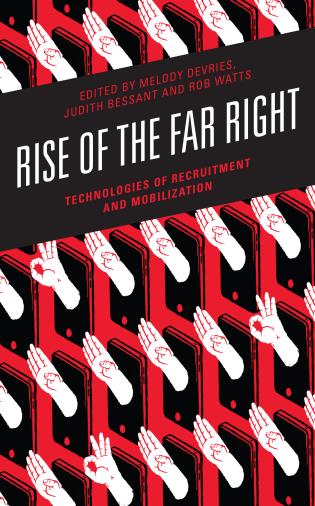Rise of the Far Right: Technologies of Recruitment and Mobilization
Edited by Melody Devries, Judith Bessant, and Rob Watts, Rowman & Littlefield, 2021, 300 pp.
Hardback, $120.00; paperback, $39.00; eBook, $37.00, ISBN: 978-1-78661-492-6; 978-1-5381-5890-6; 978-1-78661-493-3
 Rise of the Far Right: Technologies of Recruitment and Mobilization is a significant and most welcome contribution to the noticeable uptick in academic work on extreme ideologies propagating on social media platforms. In this book, Melody Devries (Ryerson University), Judith Bessant, and Rob Watts (both at RMIT University) have compiled chapters that explore how material infrastructure, political processes, and platform affordances have permanently changed the game in the recruitment and mobilization of far-right militants.
Rise of the Far Right: Technologies of Recruitment and Mobilization is a significant and most welcome contribution to the noticeable uptick in academic work on extreme ideologies propagating on social media platforms. In this book, Melody Devries (Ryerson University), Judith Bessant, and Rob Watts (both at RMIT University) have compiled chapters that explore how material infrastructure, political processes, and platform affordances have permanently changed the game in the recruitment and mobilization of far-right militants.
The editors pay particular attention to avoiding an overly deterministic approach to the power of platforms in encouraging the cultural popularity of far-right communities online. Thus, in contrast to some studies, they do not argue that platforms are the sole determinant of hate online. On the contrary, they highlight “the connectivity involved in contemporary global processes of far-right recruitment and mobilization,” and they do so by “exploring how communication technologies alter or contribute to these processes” (7). Indeed, as Simon Copland (Australian National University) notes in his chapter, “the Internet does not create or spread campaigns in a vacuum” (123); rather, the Internet capitalizes on sentiments of social alienation, which in turn resonate with offline ideologies. Platform scholars need to engage with them if they expect to understand online behaviors.
The editors also focus on various issues surrounding the nuances of the rise of the far right online. The first part of this book approaches such questions as how social media platforms mobilize support for far-right politicians in Australia and Hungary, or how Facebook and Twitter generate resources to support anti-gay marriage groups in Taiwan. This last topic works as a hinge for the second part of this volume, which focuses on the relationship between digital platforms’ affordances and anti-LGBTQ, -women, and -feminist communities. For example, JP Armstrong (York University) discusses the emergence of #straightpride, noting that “advances of marginalized groups are commonly framed as threats to a traditional way of life within right-wing political ideologies” (101). This framing results in far-right employment of digital technologies to maintain structural forms of dominance over traditionally oppressed communities.
The third and fourth parts of this book revolve around the rise of the Alt-Tech, a concept that describes the platforms and services popular among conservative ideologies. For example, Greta Jasser (Leuphana University Lüneburg) discusses the popularity of the Alt- Tech platform Gab.com, arguing that “alternative network technologies encourage...a perception of an existential threat and...unjustified persecution,” resulting in a shared identity that mobilizes users (208). This perception echoes a familiar experience among far-right militants who subscribe to these groups as a form of political activism against mainstream ‘parent culture’ that often misunderstands and excludes them.
The end of the book presents the reader with opportunities to resist the rise of the far right online. Tanner Mirrlees (Ontario Tech University) showcases how the same platforms used to spread hatred, bigotry, and misinformation online also house Left-Tubers and anti- fascist creators that work hard to counteract the far right. Mirrlees provides the example of YouTube, “one of the most exciting digital media entertainment sources of resistance to far- Right ideology” (272). This chapter ends the book on a much more hopeful note by showing how social media activists can “build campaigns, initiate rallies and spark counter-demos against the far Right, wherever it goes” (273).
The real strength of this book is how the authors succeed in identifying the complexities of far-right group members. There is no shallow portrayal of trolls and bigots in this book. Rather, all chapters help the reader understand the complexities of the collective construction of an in-group, the temptations behind anti-mainstream attitudes, and how technological affordances and digital platforms pave the way to mobilize extreme notions of normalcy and belonging among far-right supporters.
The usefulness of this book will be clear to anyone whose life is affected by the mobilization of far-right communities online. Teachers or parents could use it to understand the far-right internet as an online ecosystem in which their children are often exposed to uncensored messages of violence; journalists can rely on this volume to better understand the online communities they cover; and oppressed communities can see in these pages how to resist and repel the hatred that comes from many corners of the Web. In any case, by showing how technological affordances and platform infrastructures have aided the mobilization and recruitment of extremist supporters, this book arms its readers with potential avenues for resistance.
Tomás Dodds, Leiden University

